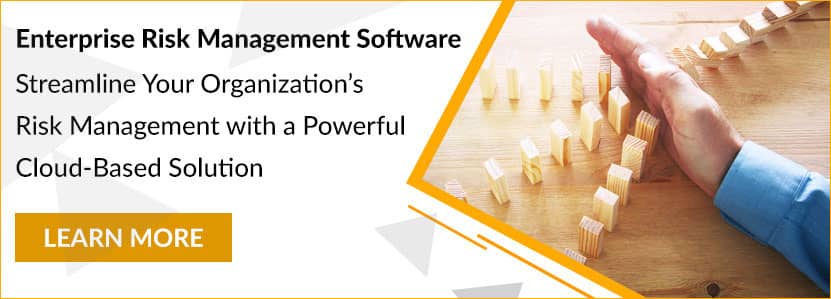Home/ Blog / Professional Risk Management Steps for Financial Success
Every business has risks that it needs to overcome. Following the steps of risk management provides an understanding and solutions to mitigate accordingly. Some organizations oversee their risk management manually, which includes spreadsheets and documentation. However, professionals recommend using automated risk and compliance solutions to make the management more efficient and streamlined.
Risk Management Process and Its Necessity
Risk management is a specified framework that points towards actionable sequences. It requires an investment of time and effort but, once implemented, delivers protection for the business. Any business that has a risk management process established receives peace of mind in addition to:
- Allowing efficient resource planning
- Tracking project costs
- Calculating ROI
- Bringing awareness to any legal requirements
- Offering flexibility in challenges
- Ensuring workplace safety

Professional Steps of Risk Management
Risk Identification
Risk identification is the initial step that starts the overall process. Banks and financial institutions face various legal, market, regulatory, and environmental risks. Through research or consultation, managers can leverage data, internal history, and experience to identify risks. Including different team members is also a promising idea as it helps brainstorm ideas and solutions.
If a manual management process is used, managers must write everything down and document it for siloed storage. However, risk management software enables the addition of each task for an effective initiation. Automated management solutions enable the creation of risk registers that adds a layer of visibility for stakeholders and team to access and remain aware of risks.
Following the steps of risk management provides an understanding and solutions to mitigate issues and make organizational compliance smooth. Share on XRisk Analysis
After creating a risk register that helps identification, the next step is to move towards analysis. Risk analysis determines the probability of risk occurrence and the impact it creates. Some risks are negligible, while others can threaten the business, and a risk analysis shows the severity of risk towards a business.
Defining the risks according to threat levels prioritizes the ones to focus more on allocating resources for mitigation purposes. The severity of impact, monetary loss, or time wastage are some factors that need consideration during analysis. The project registers of a risk management program will include this data for future reference.
Risk Evaluation
Risk evaluation comes after determining the magnitude at which the risk occurs. It allows evaluation and ranking of risks according to their likelihood of happening and their consequences. Each risk has a severity level and needs categorization. It means those that cause inconvenience may have a low rating, whereas the ones with catastrophic impacts will be a higher ranking.
Through evaluation, everyone in the organization will have a better awareness of risks and an understanding of actions to take. Higher management may let their team members handle low-level risks while involving themselves in the ones that rank higher.
Risk Mitigation or Treatment
The core of the risk management process is to set the plans and mitigate the risks. After the previously mentioned steps, experts in the relevant area can share their input for a possible solution. It is possible to neglect low-level risks or take an alternative route to avoid them. However, businesses, especially financial institutions, need to lessen those risks whenever possible. Although, they need to keep in mind that there will always be some level of uncertainty present.
Instead of using emails and manual methods to circulate this delicate information, an automated program keeps all the plans in a centralized location. Stakeholders receive all the notifications from the system and will process the approvals without delays.
Risk management solutions process the steps automatically according to set thresholds without downtime or bottlenecks. It creates an advanced preparation to lessen the detrimental effects of risks.
Review and Monitoring
Risks are always present even if you have prepared yourself and laid out a well-thought-out plan. Risk management teams need to keep an eye on the existing risk and monitor those that might probably occur. A risk management system helps the team remain one step ahead of the risk factors and get alerts whenever something happens.
The ability to continuously monitor the status of risks and forecast in advance helps face challenges with immediate responses. Reviews and monitoring also benefit employee empowerment to take decisions and mitigate risks as much as possible.
Managing Positive Risks
Risks are always regarded with a negative reputation. However, there are also positive risks or upsides of taking something unknown. A positive risk means anything good that can happen to a business.
The management of positive risks includes the same steps of identifying, analyzing, and exploiting the chance to get the best out of the situation. This could mean allocating more financial, time, or human resources to a certain task. Address the departments that deal with positive risks and include them in decisions. Spend some more time preparing processes to manage these positive upsides.

Manage Risks with Ease
Risk and compliance technology are no longer confined to just being a tool for a specific case. There are now platforms that help different employees across the organization fulfill their responsibilities—interested in seeing how your organization can benefit from risk and compliance technology? Our platform, Predict360, has been endorsed by the American Bankers Association (ABA) for risk and compliance management software. Contact our team to see what Predict360 can do for your organization.
Request a Demo
Complete the form below and our business team will be in touch to schedule a product demo.
By clicking ‘SUBMIT’ you agree to our Privacy Policy.



